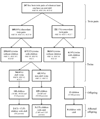Recurrence risk for offspring of twins discordant for oral cleft: a population-based cohort study of the Danish 1936-2004 cleft twin cohort
- PMID: 20799319
- PMCID: PMC2946514
- DOI: 10.1002/ajmg.a.33608
Recurrence risk for offspring of twins discordant for oral cleft: a population-based cohort study of the Danish 1936-2004 cleft twin cohort
Abstract
Our objective in this Danish population-based cohort study was to estimate the recurrence risk of isolated oral cleft (OC) for offspring of the unaffected co-twins of OC discordant twin pairs and to compare this risk to the recurrence risk in the offspring of the affected co-twin as well as to the risk in the background population. During 1936-2004, 207 twin pairs were ascertained, among whom at least one twin had an OC. The index persons were twins discordant for OC who had children (N=117), and their offspring (N=239). The participants were ascertained by linkage between The Danish Facial Cleft Database, The Danish Twin Registry and The Danish Civil Registration System. In the study OC recurrence risk for offspring of the affected and unaffected twin and relative risk were compared to the background prevalence. We found that among 110 children of the 54 OC affected twins, two (1.8%) children had OC corresponding to a significantly increased relative risk (RR=10; 95% CI 1.2-35) when compared to the frequency in the background population. Among the 129 children of the 63 unaffected twins, three (2.3%) children were affected, corresponding to a significantly increased relative risk (RR=13; 95% CI 2.6-36) when compared the background prevalence. We concluded that in OC discordant twin pairs similar increased recurrence risks were found among offspring of both OC affected and OC unaffected twins. This provides further evidence for a genetic component in cleft etiology and is useful information for genetic counseling of twin pairs discordant for clefting.
Copyright © 2010 Wiley-Liss, Inc.
Figures



Similar articles
-
Exploring Subclinical Phenotypic Features in Twin Pairs Discordant for Cleft Lip and Palate.Cleft Palate Craniofac J. 2017 Jan;54(1):90-93. doi: 10.1597/15-190. Epub 2016 Feb 16. Cleft Palate Craniofac J. 2017. PMID: 26882109 Free PMC article.
-
Cleft-twin sets in Finland 1948-1987.Cleft Palate Craniofac J. 1996 Jul;33(4):340-7. doi: 10.1597/1545-1569_1996_033_0340_ctsif_2.3.co_2. Cleft Palate Craniofac J. 1996. PMID: 8827393 Review.
-
Risk of oral clefts in twins.Epidemiology. 2011 May;22(3):313-9. doi: 10.1097/EDE.0b013e3182125f9c. Epidemiology. 2011. PMID: 21423016 Free PMC article.
-
Cleft lip (+/- cleft palate) in Danish twins, 1970-1990.Am J Med Genet. 1993 Nov 1;47(6):910-6. doi: 10.1002/ajmg.1320470620. Am J Med Genet. 1993. PMID: 8279491
-
Monozygotic triplets: concordance and discordance for cleft lip and palate / twin research reviews: depression in mothers of multiples; depression in mothers and fathers of ART conceived multiples; epigenetic differences in monozygotic twins; congenital anomalies in surviving twins / headlines x two: twin Chefs; the world's largest twin registry; twin table tennis champions.Twin Res Hum Genet. 2009 Aug;12(4):403-6. doi: 10.1375/twin.12.4.403. Twin Res Hum Genet. 2009. PMID: 19653841 Review.
Cited by
-
Integrative approaches generate insights into the architecture of non-syndromic cleft lip with or without cleft palate.HGG Adv. 2021 Jun 8;2(3):100038. doi: 10.1016/j.xhgg.2021.100038. eCollection 2021 Jul 8. HGG Adv. 2021. PMID: 35047836 Free PMC article.
-
MicroRNA-17-92, a direct Ap-2α transcriptional target, modulates T-box factor activity in orofacial clefting.PLoS Genet. 2013;9(9):e1003785. doi: 10.1371/journal.pgen.1003785. Epub 2013 Sep 19. PLoS Genet. 2013. PMID: 24068957 Free PMC article.
-
Genome-wide approaches (GWA) in oral and craniofacial diseases research.Oral Dis. 2013 Mar;19(2):111-20. doi: 10.1111/j.1601-0825.2012.01962.x. Epub 2012 Aug 23. Oral Dis. 2013. PMID: 22913301 Free PMC article. Review.
-
From Bench to Bedside and Back: Improving Diagnosis and Treatment of Craniofacial Malformations Utilizing Animal Models.Curr Top Dev Biol. 2015;115:459-92. doi: 10.1016/bs.ctdb.2015.07.003. Epub 2015 Oct 6. Curr Top Dev Biol. 2015. PMID: 26589935 Free PMC article. Review.
-
Exploring Subclinical Phenotypic Features in Twin Pairs Discordant for Cleft Lip and Palate.Cleft Palate Craniofac J. 2017 Jan;54(1):90-93. doi: 10.1597/15-190. Epub 2016 Feb 16. Cleft Palate Craniofac J. 2017. PMID: 26882109 Free PMC article.
References
-
- Bonnelykke B, Hauge M, Holm N, Kristoffersen K, Gurtler H. Evaluation of zygosity diagnosis in twin pairs below age seven by means of a mailed questionnaire. Acta Genet Med Gemellol (Roma.) 1989;38:305–313. - PubMed
-
- Chatzistavrou E, Ross RB, Tompson BD, Johnston MC. Predisposing factors to formation of cleft lip and palate: inherited craniofacial skeletal morphology. Cleft Palate Craniofac.J. 2004;41:613–621. - PubMed
Publication types
MeSH terms
Grants and funding
LinkOut - more resources
Full Text Sources
Medical

